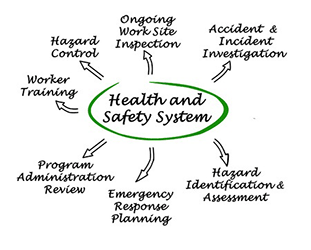 Workers Compensation Insurance: How to Cap Costly Premiums
Workers Compensation Insurance: How to Cap Costly Premiums
Workers compensation insurance plays a critical role in returning injured employees to health while protecting employers from costly civil lawsuits. When a workplace experiences too many accidents, though, escalating premiums can take a big chunk out of the bottom line. Employers need to train workers in safe work habits and shop for carriers who will partner in identifying fraudulent claims.
[quotesright]Every company wants happy and healthy employees. [/quotesright] When workplace accidents occur, it’s critically important to help the injured people recover and return to their jobs as quickly as possible. Workers compensation insurance plays an essential role by paying for medical treatment and protecting employers from civil lawsuits.
[quotes]What’s good for employee health, though, can be bad for the bottom line.[/quotes] Experience too many workplace accidents, or fail to identify and deal adequately with fraud, and escalating premiums will erode your profits.
“Workers compensation costs, if not managed well, can put a company out of business,” warns Jeffrey M. Adelson, General Counsel and Managing Partner of the National Practice Group, Adelson, Testan, Brundo, Novell & Jimenez, Santa Ana, Calif. (atblaw.net).
[sidebar]
Future Shock: Beware these Cost Drivers
A number of factors may contribute to an increase in workers compensation premiums in the years ahead. One is the rising cost of health insurance, with its attendant change in employee cost participation.
What can you as an employer expect? ReadMore >>>
[/sidebar]
Capping Costs
When premiums get too high it’s natural to consider dropping coverage altogether. Unfortunately, that’s not an option. [quotes]’Employers who do not carry workers compensation insurance are breaking the law,’[/quotes] says James J. Moore, president of J&L Risk Management Consultants, Raleigh, NC (cutcompcosts.com). “They are also flirting with bankruptcy, which may well be the only way out if they are hit with a big civil lawsuit. To go bare and hope something doesn’t happen is to chase fool’s gold.”
[quotesright]The good news is that employers have been taking steps to bring expenses under control. [/quotesright] “Workplace safety has been improving and injuries have been declining in many states in recent years,” says Peter M. Burton, Senior Division Executive for State Relations at the National Council on Compensation Insurance (NCCI), Wayne, Pa. (ncci.com). There’s also been a moderation in medical costs, thanks largely to the use of more economical outpatient treatment.
[quotes]The net result has been downward pressure on insurance bills.[/quotes] “The general trend in workers compensation premiums seems to be static or slightly lower,” says Randy Sieberg, president of Workers Compensation Consultants, based in Columbia, Missouri (workcompconsultant.com).
There’s one more reason for rate stabilization: workforce participation. “As the economy has picked up in the past few years, more people have entered the workforce,” says Daniel C. Free, President and General Counsel of Insurance Audit & Inspection, Indianapolis, IN. (insuranceaudit.com). “That creates a larger labor pool which has helped stabilize costs.”
[sidebar]
The Workers Compensation Partnership
Workers compensation insurance is a two-way street: Employees are covered for medical expenses following an accident and employers are protected against costly civil lawsuits.
But there are exceptions when claims are not paid or you as the employer can be sued. ReadMore >>>
[/sidebar]
Control Risk
Of course, conditions vary by state and employer. [quotesright]How can you control your own workers compensation bills? [/quotesright] Nothing does a better job than improving safety. “You need to do whatever you can to reduce the number of accidents and injuries,” says Burton. The reason is that premiums go up most quickly for those employers who experience a high number of claims. That means a workplace full of people who get back injuries will drive costs up more than will a single expensive car accident.
 [quotes]Accident rates affect an employer’s ‘experience modification,’[/quotes] which is the factor by which a business’s premium varies from the norm for its industry and state. “If you have fewer injuries than normal for your type of business you will get a credit in the form of a lower modification applied to your premium,” says Burton. “If you experience a higher number of injuries than normal, your modification, and thus your premium, will be higher.”
[quotes]Accident rates affect an employer’s ‘experience modification,’[/quotes] which is the factor by which a business’s premium varies from the norm for its industry and state. “If you have fewer injuries than normal for your type of business you will get a credit in the form of a lower modification applied to your premium,” says Burton. “If you experience a higher number of injuries than normal, your modification, and thus your premium, will be higher.”
Watch for dangerous conditions wherever employees are operating machinery or driving vehicles. [quotesright]These activities are prime causes of accidents. [/quotesright] Also, be vigilant about areas where people move from one level to another.
“The risk of a slip and fall is high in such places, especially if people are carrying things like cartons of inventory,” says Moore. “Make sure the steps are well marked and lighted. And reduce the slipperiness of steps by using what is called ‘anti-slip’ or ‘sandpaper’ tape. That can really reduce the chance of accidents by adding roughness to the floor.”
High shelves in the stockroom can pose special problems. Provide quality ladders for employees who need to retrieve items from upper shelves. Train workers to spot and reinforce cartons that look insecure.
Here are some other safety tips:
- Teach employees about safe lifting techniques and provide them with back braces.
- Install sufficient lighting in all areas of the building.
- Make sure the plumbing is working well so people do not slip on water.
- Make sure employees take appropriate work breaks.
While the above ideas will go a long way toward reducing costly accidents, the fact remains that every workplace is unique. Keep your own eyes open for unsafe conditions and practices. [quotes]’Avoid the temptation to turn your head the other way[/quotes] when you see dangerous conditions,’ says Adelson. “Take action to resolve them.”
[quotesright]Finally, when an accident does happen, look upon it as a learning experience. [/quotesright] Determine its cause and institute procedures to obviate similar events. “Get together with your employees and talk about steps you can take to increase safety,” says Sieberg. “Write them down in a manual and have every one sign off on them. When you take steps like this your insurance carrier will see you as a more desirable risk.”
Reduce Fraud
Call your broker to report injuries as soon as they occur. Not only is it a crime to fail to report injuries, but [quotes]delay often results in additional medical costs.[/quotes] “The longer a case stays open the higher the medical expenses, which are the biggest driver of workers compensation costs,” says Adelson. “Reporting an injury right away will help your carrier in containing medical costs and will help get the injured employee back to work with the least delay.”
[quotesright]Early reporting can also help increase the chances of uncovering fraud, because evidence is easiest to gather immediately following an accident. [/quotesright] If you do suspect fraud, start your investigation right away.
“Investigate in a non-threatening and non-emotional manner,” says Adelson. He suggests starting with relevant questions such as these: Was a Friday afternoon accident not reported until Monday morning? If so, why? Did the accident occur in a part of the building where the person had no business being? If so, maybe they were not really performing their assigned duties. Do you have cameras in the workplace that might have recorded the accident? Did anyone witness the injury?
[quotes]Ask for assistance from your insurance company,[/quotes] suggests Adelson. “Most carriers have what are called special investigation units that can help assess fraud.” They can also provide you with handouts or posters that explain the seriousness of bogus claims.
You can help reduce the incidence of fraud by treating people well. “Develop a fair, honest workplace culture,” says Adelson. [quotes]Unhappy and bitter people who don’t value their jobs are going to file claims[/quotes] and take them all the way. People who respect their employers and workplaces will want to get back to work quickly.”
Shop Smart
While a safe workplace is the best way to control workers compensation costs, you should also select the right insurance providers. “You want a broker who understands your business, who works with you on the front end to avoid injuries, and who will advocate for you when you have an issue with your carrier,” says Adelson.
Such as? “Suppose you believe a certain claim should be investigated for fraud and your carrier balks at doing so,” poses Adelson. “You run the risk of a fraudulent claim leading to a higher premium at renewal time unless your broker steps in and urges the carrier to investigate.”
[quotesright]And speaking of carriers, don’t pick one solely on price. [/quotesright] “Ask your broker to suggest a company that will give you sound advice about avoiding losses and minimizing risks,” says Adelson.
“Ask if the carrier will perform ergonomic reviews and educate you on what to do when accidents or injuries occur. And find out if the carrier maintains fraud departments that can help you investigate questionable accidents.”
You might first approach so-called “multi-line” carriers who also sell insurance in other categories such as property, general liability, and automobile. However, many such companies have been exiting the workers compensation market because the low interest rate environment makes it hard for them to make up any losses with profits from other lines. That leaves “single line” carriers who specialize in workers compensation. [quotes]Beware though: Many of these have become more selective in their clientele,[/quotes] favoring only those employers who have a history of risk control and claims management.
Shopping your coverage can be a smart way to cut costs, and your broker should be able to suggest additional channels. [quotesright]Look into Professional Employment Organizations (PEO’s), [/quotesright] suggests Moore. “Many of them are accustomed to handling smaller accounts with higher risks. They also provide other fee-based services, which often allows them to provide workers compensation insurance at a more economical price. Finally, [quotes]they often are willing to take on employers that might be rejected by insurance carriers.[/quotes]
Employers who are turned down by insurance carriers are forced to use the state pools, where premiums may run up to 25 percent higher than those in the private sector. Service may also be less than optimal. For example, there may be no one who will run an ergonomic review to help you reduce injuries.
Keep in Touch
No one wants to experience the pain and cost of an accident, but the experience can be mitigated by an understanding employer. “Once an accident occurs, stay in close contact with the injured worker,” says Burton. [quotesright]Helping workers get back into employment as quickly as possible is an excellent way to help reduce expenses that may lead to premium hikes. [quotesright] That’s because the employee who returns to work will be collecting less compensation from the carrier, not only for lost salary but also for medical expenses.
Employees are likely to be enthusiastic about any program that gets them back to work early. That’s because they will be compensated at their normal salary rather than the at the partial level mandated by the workers compensation system. Bear in mind, too, that adjustors will suspend the workers compensation claims of those employees who refuse offered positions, even if those positions are for less demanding duties not normally performed.
[quotesright]One final tip: Don’t take claims personally. [/quotesright] “Understand that every employer is going to face an occasional workers compensation claim,” says Adelson. “Good management is usually a matter of mitigating rather than avoiding losses.”














